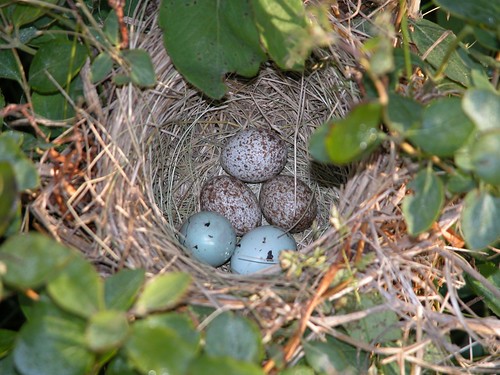

Apparently more than one might think! In a recent Washington Post article, I read about some research done by an avian ecologist at the Illinois Natural History Survey. The researcher, Jeffrey Hoover, noticed that female cowbirds leave their eggs in the nests of other birds. These eggs and, eventually, the hatchlings were taken care of by the “host” birds.
Out of curiosity, the researchers removed some cowbird eggs from the nests of the other birds. Strangely, these nests were subsequently destroyed. Come to find out, the female cowbirds were keeping an eye on the nests where they placed their eggs and, if anything happened to them, they would destroy the nest in retaliation. The “host” birds raised the “foreign” hatchlings because this ensured some of their own chicks would survive – otherwise, “mobster” cowbirds killed all the chicks.
Frans de Waal, a primatologist at Emory University, says that the difference between humans and cowbirds is that the cowbirds aren’t thinking through their nest-trashing strategy. Gangsters like Laurence Fishburne as “Bumpy Johnson” in the movie Hoodlum certainly do: “You've been warned. Get ready for your final thrill. It's curtains, Dutch. The jig is up.”
It’s hard to know whether cowbirds think “the jig is up” before they destroy the nest of another bird or not. Nevertheless, this is an interesting example of how human behavior is not fundamentally different from animal behavior. In fact, De Waal argues that much of human behavior may have been hard-wired into us through evolution. That some behavior is “built-in” helps to explain how certain “intuitive” (and not necessarily effective) behaviors like tit-for-tat are used the world over and influence many aspects of social interaction and perception. If, as some behavioral researchers now think, we’re hard-wired to use intuitive (and potentially inefficient) strategies like tit-for-tat, we need to make an extra effort to get beyond our constraints and pursue more effective ways to interact – something relevant to thinking about negotiating.
Ashley Thornton
References
Vedantam, Shankar. “Behavior May Suggest We’re Not Only Human.” Washington Post, March 19, 2007, via Washington Post online, http://www.washingtonpost.com/.
Photos by Pete Baer show three speckled cowbird eggs in the nest of a red-winged blackbird and the same nest after the blackbird eggs were pushed out. Retrieved from www.flickr.com.
Wednesday, 21 March 2007
What do gangsters and cowbirds have in common?
Posted by Disarmament Insight at 17:31
Labels: cowbirds, Frans de Waal, gangsters, intuitions, multilateral negotiations, retaliation, Thornton





0 comments:
Post a Comment